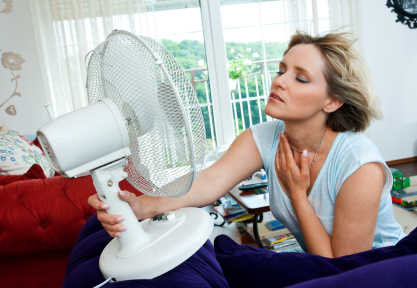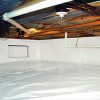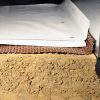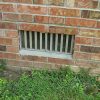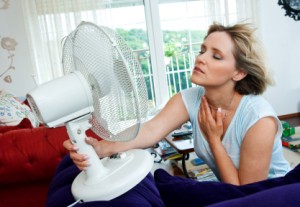 Whether you suffer from soaring temperatures for 2 months a year or 6, there are some no-sweat things to can to make your life cooler. The methods you choose will depend on several variables, not the least of which is your own internal thermostat. Some people can tolerate more heat than others. If you’re not afraid of a little perspiration, for example, any number of low-tech solutions may be all you need.
Whether you suffer from soaring temperatures for 2 months a year or 6, there are some no-sweat things to can to make your life cooler. The methods you choose will depend on several variables, not the least of which is your own internal thermostat. Some people can tolerate more heat than others. If you’re not afraid of a little perspiration, for example, any number of low-tech solutions may be all you need.
As a bonus, low-tech tends to be greener and less expensive than mechanical solutions. If your tolerance to heat is low, or if you live in a climate where the heat is relentless, choose from one of several central air conditioning systems. They are quieter and more efficient than window air conditions and won’t obstruct your windows. They’re also more secure, giving intruders one less way to break into your home.
Low-tech cooling solutions
Low-tech or passive cooling strategies depend on four common-sense strategies:
- Make shade
- Keep the heat out
- Catch a breeze
- Trap cool air inside
Making shade
Making shade can be done in many ways. Planting trees, building a pergola, installing awnings or shutters all help keep a home several degrees lower than the outdoor temperature. The key things to remember here are that you must do these things to your home’s southern exposure and that they should be outside the house. Pulling blinds, shades, or drapes inside the house are of little help with reducing temperatures because once light passes through a window or patio door, it’s too late. The thermal energy is already trapped inside the home. Trees will offer shade, but limit their placement to the east and west. Otherwise, you will block passive solar gain through windows and patio doors during the winter, when it’s desirable. Even deciduous trees, with their leaves fallen, can block significant amounts of valuable solar radiation – 30 to 60 percent of it.
Keeping heat outside
Keeping heat outside can be done in several ways. Thermal insulation, normally thought of in terms of keeping heat in during the winter, is just as important for keeping summer heat out. If you haven’t already done it, install as much insulation as you can in the attic and in exterior walls. Dense-packed cellulose and rigid foam board insulation are good choices. (See recommended levels of insulation for your region at http://www.energystar.gov.) If you have an air handler and cool air distribution ducts in the attic, put the insulation between or across the rafters rather than in the floor. This will reduce the load on your air conditioning equipment.
Low-E (low emittance) window coating is another way to keep heat out. It can reduce solar heat gain by as much as 70 percent. The expensive way to accomplish this is to buy new windows with a low-E coating for south-facing windows. The cheaper way is to apply a low-E film to the inside of your windows. Pros can do this job quickly and efficiently. DIY films are often difficult to apply without leaving bubbles and tears.
The choice of lighting fixtures and appliances can help keep a home cool. Efficient LED and CFL light bulbs, for example, produce far less heat than common incandescent and halogen bulbs. A range vent that moves hot air outdoors reduces interior heat gain due to cooking. Similarly, using an outdoor grill or outdoor oven during the summer will also help keep your home cooler.
Catch a breeze
A breeze cools you because it causes the moisture on your skin to evaporate. As the moisture evaporates, it literally absorbs heat from your skin, producing a cooling effect. To catch a breeze indoors, you have to move air – and that usually means fans and open windows. A window fan is one option. A better option is two window fans, one positioned to move air in and the other adjusted to move air out. This is much more effective, especially in second and third story rooms, than trying to move air with a single fan.
Ceiling fans move air, too, but bear in mind that they will only make you feel cooler if they are blowing air toward you. This usually means a counterclockwise rotation (as you’re looking up at the fan). In winter, run the fan clockwise on low speed to help circulate warm air near the ceiling across the ceiling and down the walls to the floor. Most fans include a switch that allows you to reverse fan blade rotation.
Trap cool air inside
Another cooling strategy is to trap cool air inside. This works best in climates where the nights are significantly cooler than during the day, such as in hot dry climates of the Southwest. It also works in some temperate and cold climates. The idea is to move cool air in at night and then to trap it there by closing windows in the morning. To move hot air out and cool air in, you may use window fans — but a more effective device is the whole house fan. It is installed in a framed opening in the attic floor. Come evening, open first floor windows and turn on the fan to draw cool air through the house. You typically won’t have to run the fan long. (Just be sure to devise a way to seal and insulate the fan opening come winter, or it will become a huge hole in your home’s insulation envelope.)
Air sealing is critical for keeping cool air inside, just as it’s critical for keeping heat inside. To find out all the places where air leaks in and out of your home, contact a company that conducts home energy audits, such as the Dr. Energy Saver company in your area. It uses a blower door depressurization test to locate all the leaks.
Mechanical solutions
If you live where the heat is unrelenting for several months of the year, you will want a central air conditioning system. They are capable of cooling every room of the house by circulating cool air through ducts in floors, walls, and ceilings. The cool air enters rooms through wall or ceiling registers. Return registers and ducts move the room air back to the central unit. The air ducts are typically the same ones used by the home’s forced-air heating system. Which type of central air conditioning system you choose depends upon where you live, how much of the house you need to keep cool, and the type of heating system you have.
There are three basic options:
- Split systems
- Package systems
- Ductless or mini-split systems
Split systems
In split system air conditioners, the evaporator coils are located inside the home, typically in a plenum above the furnace or in a separate air handler that is frequently located in the attic. The condenser, compressor coil, and a large cooling fan are stationed outside in a metal cabinet. Insulated copper tubing carries the refrigerant between the outdoor and indoor components. Split systems are an economical way to add air conditioning to homes that already have a forced-air heating system and the associated air ducts.
Packaged system
With a packaged system, all components are located outside the house, typically on the roof or mounted to a concrete slab next to the foundation. Cool air is moved via insulated ducts into the home and is then circulated to rooms in the home via additional duct work.
Ductless
Ductless or mini-split systems are best suited to households that have non-ducted heating systems, such as hydronic (hot water) and radiant systems, and where installing new ducts for a central system would be expensive or not feasible. Like central air systems, noisy components are outside of the living space and your windows remain accessible and unobstructed. Unlike central systems, however, mini-splits are limited to cooling a few rooms. In addition, the indoor units will take up significant wall space.
With a ductless system, the compressor/condenser components sit outside. Indoor units, each of which house an evaporative coil and blower, are typically mounted on interior walls near the ceiling. They can also be ceiling-mounted or flush-mounted above a drop ceiling. A conduit that includes a power cable, refrigerant tubing, suction tubing and a condensate drain connect each indoor unit to the outside unit. The maximum run is 50-ft. and the lines require an area the equivalent of a 3-in.-dia. hole to pass through a wall.
Whatever system you choose, be sure it’s Energy Star rated. It should have a SEER rating of 15 or better. Today’s central air conditioning units use 20 to 40 percent less electricity than 10 years ago.

